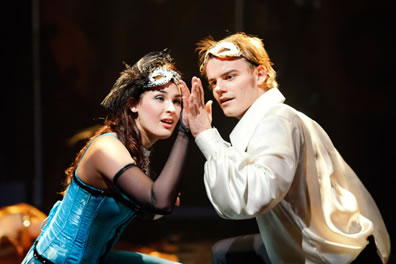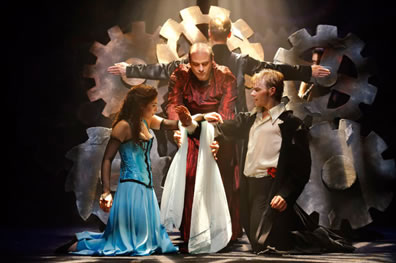Romeo and Juliet
Silent Shakespeare Yields
Emotional Depth and Visual Electricity
Synetic Theater, Arlington, Va.
Wednesday, December 14, 2011, C–111&112 (center front stalls)
Directed by Paata Tsikurishvili
I find it puzzling that any discussions I’ve had or read of Synetic Theater addresses the alleged blasphemy of the company doing Shakespeare without words. What is Shakespeare without his words? the thinking goes.
Well, for one thing, great Shakespearean theater. Look at my list of Top 40 Shakespeareances, and at 22 you’ll find Rudolph Nureyev’s Romeo and Juliet, a ballet. No words. However, staging that incorporated Shakespeare’s imagery and choreography that incorporated the tone and emotion of Shakespeare’s poetry is Shakespeare.

Natalie Berk as Juliet and Alex Mills as Romeo do one of their hand pas de deuxs as they meet at the Capulet's party in the Synetic Theater production of Romeo and Juliet. Synetic presents Shakespeare through dance, mime, and lighting. Photo by Graeme B. Shaw, Synetic Theater.
Synetic tells Shakespeare’s version of the Romeo and Juliet story with dance and mime, folding in not only Shakespeare’s imagery but also the thematic interpretations of director Paata Tsikurishvili and his choreographer-wife, Irina. The set designed by Anastasia R. Simes was the interior of a clock as “Romeo and Juliet highlights the exuberance and passion of youth in which time seems to both stop and accelerate,” Tsikurishvili writes in his director’s note. Dancers carrying gears play out the opening brawl, and we see both Romeo and Juliet buffeted by time, as it were.
The Shakespearean allegorical arc the Tsikurishvilis dwelled on most was the palm-to-palm line at the lovers’ meeting. In a dream sequence emerging out of the opening brawl (metaphorically, the young lovers’ natural romantic passions frustrated by their families’ feuding), Alex Mills as Romeo and Natalie Berk as Juliet danced a pas de deux focused on their hands dancing their own pas de deux. Arms, palms, and fingers engaged in intricate weaving like two birds in mating flight. They performed another such ballet of hands when they met at Capulet’s party. In this telling, Juliet literally turned out to be the woman of Romeo’s dream, and vice versa, rather than the two tripping headlong over a sudden, fateful strike of love at first sight.
In the plotline, the dream replaces Romeo’s doting on Rosaline (Benvolio, the friend Romeo confesses to, is totally excised). It is one of three notable insertions Paata Tsikurishvili made to Shakespeare’s tale, and the other two had more merit than the dream (even if the dream was a dream moment for those of us who love dance). In one, the whole Capulet family interacted with Juliet right before Lord and Lady Capulet (Peter Pereyra and Salma Shaw, respectively) introduced her to Paris (Scott Brown) and broached the subject of marriage with her. Tybalt (Ryan Sellers) is in this scene, and we see a love between the two cousins resembling that of an older brother watching out for his doting younger sister. Tybalt even eyed Paris warily before discovering Romeo at his uncle’s party. Establishing this Juliet-Tybalt relationship deepened her tragedy later when her new husband killed her brother-like cousin.
This also placed a richer perspective on the other extra-Shakespearean scene. Where Shakespeare jumps to the morning after the couple’s wedding night, Tsikurishvili showed us the wedding night. Before the lovers consummated their marriage (danced in silhouette behind a scrim), Juliet had to comfort a remorseful Romeo. This prompted a rarity for me: questioning Shakespeare’s own plot management. What a moment fraught with so many emotions, when Juliet and Romeo have their first meeting after Tybalt's killing and Romeo's sentence of banishment. However, Shakespeare chose to skip past that moment and go directly to the lark waking them up the following morning. Had he written this play five years later he might have given us the night.
Such a scene would require incredible acting to pull off effectively, and Berk was such an actress. Her Juliet started wide-eyed and uncertain about the notion of romance when she met Paris, and then Romeo awakened a thrilling passion in her. At the moment she needed to comfort her doomed and despondent lover, she became a woman, showing compassion that then led to the show’s passionate centerpiece dance behind the scrim. (Kudos here to Colin K. Bills’ lighting design, especially in this foreplay dance as other actors on stage wielded spotlights on the two lovers, alternating from different angles, adding depth and visual dimensions to the dancers like the rising sun playing off a Utah cliff face.) By the time we got to the tomb, Juliet had left the wide-eyed girl far behind, and here was a weary woman who had seen too much of the world and the crush of romance in such short time.

Irakli Kavsadze as the Friar marries Juliet (Natalie Berk) and Romeo (Alex Mills) while another dancer serves as the church's cross in the Synetic Theater production of Romeo and Juliet, which was set in the interior of a clock. Photo by Graeme B. Shaw, Synetic Theater.
Mills’ Romeo was not that much different in personality from the rest of the gang hanging out with Mercutio, but he had a natural sweetness that flourished when he came upon Juliet. Boyish face, ready smile, lithe bearing: Paris was a good-looker, but no way Juliet wouldn’t prefer this rock star Romeo. Philip Fletcher’s Mercutio was a clown, recklessly so, and he maybe harbored a crush on Romeo, though he relished taking on all comers; even fighting Tybalt was erotic arousal for this Mercutio. Sellers’ Tybalt was a young man with studied manners but dedicated to a machismo code that could not broach Romeo’s original slight at the party nor his literal embrace of affection later in the plaza. The subsequent fight sequences between Fletcher and Sellers and then Sellers and Mills were exhilarating performances full of leaps, tumbles, and a real sense of threat; the acrobatic dancing got our hearts racing as much as watching two young men heatedly engage in a real knife fight would have.
In addition to choreographing these electrifying fight scenes and the elegant hand ballets between Romeo and Juliet, Irina Tsikurishvili gave herself, playing Nurse, the comic dance of the night in her fight with Mercutio. It was just as energetic and acrobatic as the knife fights, but played for laughs as first Mercutio controled the tussle, culminating in his spinning the Nurse through the air, and then Nurse gained the upper hand, culminating in her likewise spinning Mercutio (by the way, Fletcher is a tall guy, and Irina matched him strength for strength).
The entire ensemble was strong in dance and effective with mime, with Irakli Kavsadze giving a fully and touching mime performance as Friar Laurence, showing genuine affection for Romeo (and tender counsel later for Juliet) as the father figure he truly is in the play.
With performances this good and storytelling this insightful, Synetic Theater’s “Silent Shakespeare” is both a valid contribution to the Shakespearean discussion and enjoyable theater.
Eric Minton
December 18, 2011
Comment: e-mail editorial@shakespeareances.com
Start a discussion in the Bardroom



 Find additional Shakespeareances
Find additional Shakespeareances